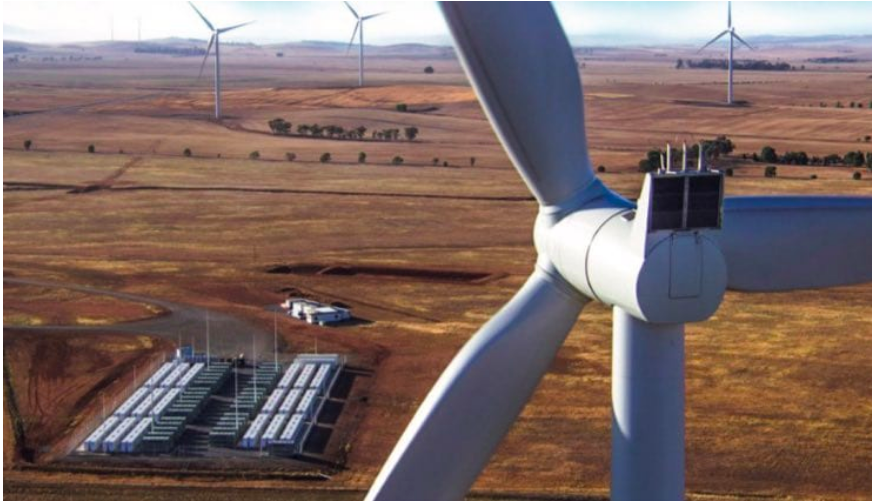It’s taken just a little over two years for the Tesla big battery, officially known as the Hornsdale Power Reserve, to re-coup in revenue the cost of construction of what remains the world’s biggest lithium ion battery.
Neoen, the French based owner and operator of the Tesla big battery at Hornsdale revealed on Thursday (Paris time) that the installation recorded five fold increase in revenue in the first quarter underpinned a 65 per cent boost in first quarter revenue for the group as a whole.
The huge revenue boost from battery storage was the result of unusual – and likely unrepeatable – conditions that occurred when a tornado tore down the main transmission link between Victoria and South Australia in late January.
That required the Hornsdale, the biggest lithium-ion battery storage facility in the world, and other two smaller big batteries in the state – Lake Bonney and Dalrymple North – to play critical roles in managing system security in South Australia which was forced to operate as an effective energy “island” for nearly three weeks.
The intervention – mandated and supervised by the Australian Energy Market Operator – resulted in a revenue increase from storage operations to €21.6 million ($A36.2 million) in the first quarter of 2020, compared to €4.2 million in the first quarter of 2019. A small fraction of this revenue came from other small storage facilities operated by Neoen.
The significance of this number is that the Tesla big battery at Hornsdale earned more revenue in the first quarter than it did in all of last year, when it recorded a 14 per cent rise in annual revenue to €20.5 million ($A33.2 million).
It also means that total revenue from the Hornsdale battery has already exceeded its construction cost (around $A96 million) in little more than two years since it began operations in late 2017. At least half of that will be reflected as net income, indicating a phenomenal return on investment for the Hornsdale big battery.
At the same time, the Hornsdale battery is estimated to have delivered savings of at least $150 million to consumers by keeping electricity and system costs below where they would have been in its absence, when the market was totally controlled by the state’s existing gas operators.
And it has played a critical role in keeping the lights on, and is recognised for playing a critical role in helping planners and system engineers plot the path towards a zero carbon grid. This from a project once derided as being as useful as the Big Banana by the current prime minister.
The Hornsdale big battery is now being expanded, and by the end of June is expected to have capacity of 150MW/194MWh – up from 100MWh/129MWh – and will add new services to its portfolio.
This includes critical new roles in providing inertia and “grid forming” capabilities that will advance the role of battery storage in pushing conventional generation such as gas plants out of the system.
“(It) will showcase the complete benefits that grid-scale batteries can provide to the National Electricity Market (NEM) and Australian consumers,” the company says. This will be important as South Australia moves towards the state Liberal government’s target of reaching “net 100 per cent renewables” before 2030.
The strong performance of the Hornsdale battery enabled Neoen to deliver a 61 per cent lift in revenue of €95.8 million in the first quarter of 2020. At constant exchange rates, revenue was up 65%.
“During this period, the Australian Energy Market Operator asked Neoen to operate the HPR battery facility to increase grid stability. That gave Neoen a key role in maintaining grid’s reliability, while continuing to keep electricity costs down for Australian users,” the company said in a statement.
The incident in South Australia had some impact on its wind operations – it also operates the neighbouring 309MW Hornsdale wind complex – which suffered some curtailment and increased costs due to the mandated AEMO interventions.
But overall revenue growth for Neoen was strong, with wind revenue up 24 per cent to €35.8 million, and solar becoming the company’s biggest revenue earner for the first time with a 46 per cent rise to $€38.2 million.
Neoen also operates the Griffith, Parkes and Dubbo solar farms in NSW and the Numurkah solar farm in Victoria, and recently won a contract with Queensland’s CleanCo to build the country’s biggest solar farm – a 400MW facility – at Western Downs in the south east of the state.
Neoen is also completing the 212MW Bulgana wind farm in Victoria, which is paired with a 20MW/34MWh big battery, although this project has been delayed by broader connection problems and grid congestion in that part of the grid, at a cost to both Neoen and its construction contractor.
Neoen also has a number of other huge projects that propose to combine a varying mixture of wind, solar, battery storage and hydrogen electrolyses, including at Crystal Brook and Goyder South in South Australia, and the Kaban green energy hub in north Queensland.
It is also proposing an even bigger battery – the Victoria big battery – of around 600MW and as yet undecided amount of storage as part of its proposed tender to deliver an upgrade of the capacity of the main transmission link between NSW and Victoria.
Neoen has 3GW of wind, solar and storage capacity in operation or under construction, aims to lift this to 5GW by the end of 2021. It also operates in Europe and Latin America.
Source:Paper.li


